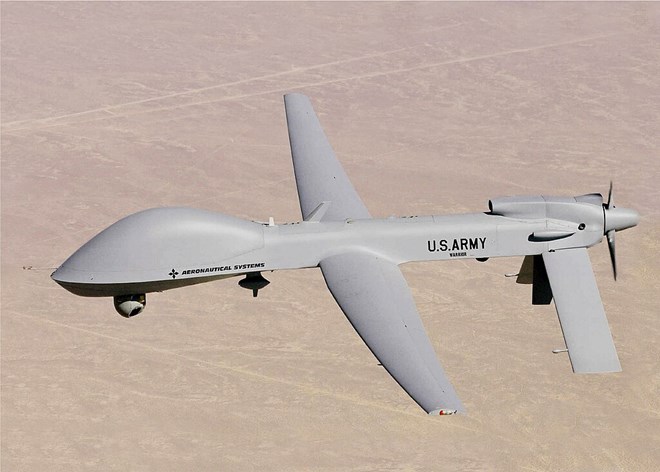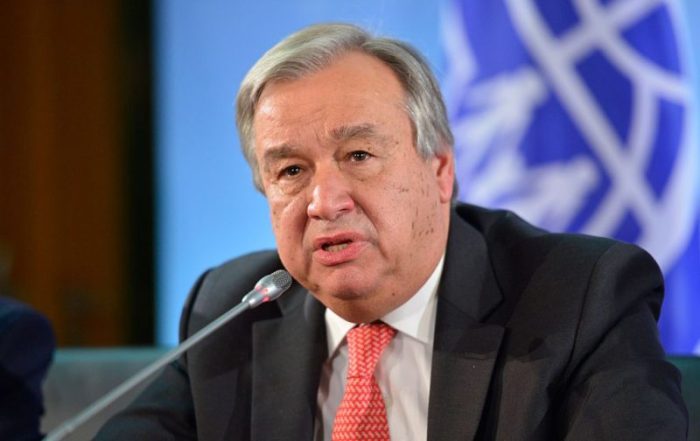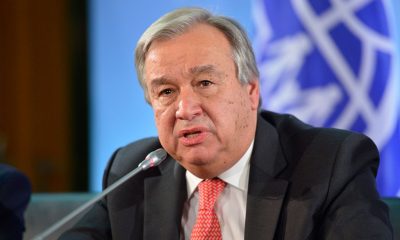Top stories
U.S. Confirms MQ-1C Gray Eagle Drone Crash in Somalia

The United States Africa Command (AFRICOM) confirmed that an American-operated MQ-1C Gray Eagle drone crashed on Tuesday in Somalia, clearing up earlier reports from local media that misidentified the aircraft as a Turkish Bayraktar TB2. According to AFRICOM, the crash occurred around 12:40 p.m. on November 5, near Farsooley, a village under Al-Shabaab control approximately 130 kilometers southwest of Mogadishu.
Shortly after the crash, Al-Shabaab fighters reportedly secured the wreckage, concealing it with branches to evade aerial detection. Initial reports from sources like Hiiraan Online incorrectly attributed the crash to a Turkish TB2, likely due to Turkey’s active military support for Somalia’s efforts against Al-Shabaab.
AFRICOM clarified that the MQ-1C Gray Eagle’s crash was not likely caused by hostile fire. An investigation is underway to determine the technical reasons behind the incident, with AFRICOM pledging to release further information as findings develop.
The MQ-1C Gray Eagle, produced by General Atomics Aeronautical Systems, is a highly capable unmanned aircraft system designed for long-endurance missions, including reconnaissance, surveillance, and precision strikes. Originally entering service with the U.S. Army in 2009, the drone has since seen multiple upgrades, such as improved sensors and increased payload. With an endurance of up to 25 hours and the capacity to carry four AGM-114 Hellfire missiles, the Gray Eagle provides real-time intelligence and targeted strike capabilities at altitudes up to 29,000 feet.
Al-Shabaab, an al-Qaeda-affiliated group, maintains significant influence over parts of southern Somalia. The crash site’s proximity to an Al-Shabaab stronghold highlights the challenges international forces face in supporting Somalia’s counter-terrorism operations. While the U.S. primarily aids through intelligence and aerial support, Turkey has also become a critical ally, offering Somali forces training and equipment in the fight against the militant group.
As AFRICOM’s investigation progresses, further details are expected to shed light on the technical failure that led to the loss of the MQ-1C Gray Eagle, a drone valued at approximately $21 million.
Middle East
The Iran Leak that Shook Israel’s Security State

Did Netanyahu just leak Israel’s war plans to save his image? Netanyahu under fire after NYT bombshell reveals Israeli plans to strike Iran; officials call it “one of the most dangerous leaks in Israel’s history.”
A crisis is unfolding in Israel—not just over Iran’s nuclear threat, but over a leak that’s ignited a political firestorm in Jerusalem. A senior Israeli official has told The Jerusalem Post that the recent New York Times report detailing Israeli plans to strike Iran’s nuclear program with US support is “one of the most dangerous leaks in Israel’s history.”
This isn’t just about national security. It’s about political survival.
Prime Minister Benjamin Netanyahu now finds himself at the center of a storm, with multiple Israeli politicians accusing him of deliberately leaking the classified operation details to shield himself from political fallout. His critics argue that the leak served as a distraction—a calculated maneuver to silence accusations that he talks tough on Iran but fails to deliver decisive military action.
Former defense minister Avigdor Lieberman didn’t hold back, tweeting: “How lucky we were that Netanyahu wasn’t prime minister when we bombed the nuclear reactors in Syria and Iraq.” His point? Past leaders acted. Netanyahu, critics say, leaks.
The revelation that Israel seriously weighed a joint strike with the US against Iran’s nuclear facilities—one that could have started a regional war—has sent shockwaves across both the intelligence and military communities. Not only was the IDF reportedly prepared to carry out the operation, but the entire strategy was contingent on US approval, which Trump ultimately denied in favor of diplomatic talks.
Now the damage is twofold: Iran has been tipped off, and Israel’s deterrence narrative has taken a hit.
While Netanyahu continues to claim that Iran will never be allowed to go nuclear on his watch, the Israeli public and global observers are left wondering: Did he just sabotage one of the most sensitive defense strategies of the decade—for the sake of headlines?
This leak doesn’t just threaten operational secrecy. It weakens trust within Israel’s security establishment, sends mixed signals to Tehran, and erodes confidence among US allies. In the end, the greatest threat to Israeli security might not come from Iranian centrifuges—but from within Israel’s own political machinery.
Top stories
Al-Shabaab’s Resurgence Exposes Flaws in Somalia’s War Strategy

Militant capture of Aadan Yabaal questions Mogadishu’s military momentum amid eroding public trust and fragile international support.
The fall of Aadan Yabaal to Al-Shabaab isn’t just a battlefield loss—it’s a strategic and psychological blow to the Somali government’s credibility. President Hassan Sheikh Mohamud’s attempt to reassure the nation that “momentum shifts” are part of war may ring hollow to a public that’s heard the same line since the early 2000s. After two years of claiming gains, how did the jihadists storm a symbolic stronghold with apparent ease?
Al-Shabaab’s capture of Aadan Yabaal shows the Somali military’s offensive was never as comprehensive or irreversible as claimed. Frontline forces remain underfunded and stretched thin. Tactical vacuums and inconsistent control of retaken towns are leaving doors wide open for ambushes. If elite units can’t hold strategic hubs like Aadan Yabaal, then what is really under government control?
President Mohamud’s warning about waning international support is an admission of dependency—Somalia’s war effort hinges more on foreign aid than national resolve. With US counterterrorism strikes declining, AMISOM rebranded into a lighter version, and donor fatigue mounting, the illusion of “progress” is rapidly dissolving. Al-Shabaab isn’t just surviving—it’s adapting, exploiting weaknesses, and regaining ground.
The president may plead for morale, but it’s morale in Mogadishu that’s collapsing. Every time Al-Shabaab plants its flag in a reclaimed town, it sends a louder message: Somalia’s government doesn’t have a monopoly on violence—or on legitimacy. Community militias like Ma’awisleey may be willing to fight, but they can’t hold ground without serious logistical backing. Without air support, intelligence coordination, and a functioning national army, this war will keep repeating itself.
If Somalia wants to avoid becoming a permanent failed state, its leaders must stop spinning failures into PR soundbites and start admitting the cracks in the system. The enemy is inside the walls—and still marching.
EDITORIAL
Somaliland’s Political Class: Selling Out a Nation for Profit

Somaliland’s greatest obstacle isn’t foreign policy — it’s internal corruption, nepotism, and betrayal from politicians who profit while the nation suffers. WARYATV exposes the rot.
While the people dream of recognition, their leaders cash in on betrayal.
Somaliland’s path to recognition has never been blocked by Mogadishu, Ethiopia, or even the UN. It has been sabotaged from within. Behind the speeches and flag-waving lies an elite class of politicians and businessmen who treat the nation not as a cause to fight for, but as a franchise to milk.
These men—most unelected, many unqualified—have spent decades playing the long game of stagnation. They talk sovereignty while banking silence. They chant patriotism while laundering public funds. And worst of all, they have created a system where anyone smart enough to challenge the decay is labeled a threat.
This is the intellectual apartheid of Somaliland: Educated minds are shunned, sidelined, and smeared because they expose what the ruling class desperately wants to hide—their fear of change, their fear of meritocracy, and their fear of losing control.
The result?
- Corruption reigns unchecked.
- Healthcare and education are abandoned.
- National planning is a joke.
- Recognition is sabotaged deliberately—because an internationally recognized state comes with rules and transparency, and that threatens the clan cartel currently in charge.
Somalilanders aren’t poor because of geography. They’re poor because the elite keep them that way. They’re told to wait, to pray, to believe in “diplomatic progress” while deals are cut behind closed doors and loyalty is bought, not earned. And the biggest betrayal? Business elites who actively oppose recognition, because they fear competition more than they love their flag.
Hadrawi warned us. Intelligence is punished. The thinkers, the visionaries, the honest ones—they are exiled, not by the world, but by their own people in power.
Somaliland isn’t failing because of external pressure. It’s failing because of internal cowardice. A nation hijacked by men who want the title of president, not the responsibility of statehood.
The people must stop idolizing thieves and start demanding truth. Somaliland’s dream is not dead—but it’s being strangled in silence.

Time to break the silence.
Analysis
America Pulls the Plug on Somalia: UN Funding Blocked, AUSSOM on the Brink

Trump eyes embassy closures as US rejects UN plan to fund peacekeepers in Somalia — Mogadishu’s last lifeline in peril.

The US shocks the UN by rejecting funding for African Union forces in Somalia, just as Trump weighs closing the US Embassy in Mogadishu. With Al-Shabaab advancing and oil politics heating up, is Somalia doomed to implode?
The United States just signaled the collapse of Somalia’s last fragile security architecture — and it did so with chilling clarity. Washington has publicly rejected UN efforts to fund the African Union Stabilization Support Mission in Somalia (AUSSOM), effectively gutting any hope for predictable peacekeeping operations in a country teetering on the edge of collapse.

This isn’t just a bureaucratic snub — it’s a geopolitical death sentence for Somalia. Al-Shabaab militants are already testing the vacuum, launching a multi-pronged assault on Adan Yabaal, a key military base in Middle Shabelle. If confirmed, the town’s fall would mark the largest strategic loss since Somalia launched its offensive against terror in 2022.
UN Secretary-General António Guterres warned the Security Council: no funding, no peace. But the US—under Trump’s second-term posture—is slamming the door shut, labeling Somalia as unfit for a hybrid funding model under Resolution 2719. Diplomats are in a panic. Meanwhile, Trump is reportedly planning to close up to 30 diplomatic missions, with Mogadishu’s embassy topping the list.
Somalia’s response? Desperation disguised as diplomacy. The FGS is now peddling oil blocks in contested territories like Nugaal Valley. In a flashy announcement on X, Somalia’s ambassador to the US declared “Somalia is open for drilling,” targeting American firms with an offer it legally and militarily cannot secure.

Somalia’s Ambassador to the United States, Dahir Hassan Arab
The move comes after Somalia’s recognition of SSC-Khaatumo — a region still engulfed in the political wreckage of its war with Somaliland.
This isn’t about development. It’s about weaponizing recognition, resource manipulation, and fake sovereignty in a bid to win Trump’s favor and undermine Somaliland’s momentum.
But while Hargeisa builds forests and attracts foreign media praise, Mogadishu is drowning in debt, insurgency, and denial. The West is tuning out, and even the UN is losing patience. The US, once Somalia’s diplomatic oxygen, is now pulling the plug.
Somalia is not rising — it’s being unplugged.
Commentary
China Slaps Trump With Brutal Reality Check as Trade War Turns Global

Chinese state media blasts Trump’s tariff war, accuses U.S. of freeloading on globalization while Xi strengthens Asian alliances.
China lashes out at Trump’s economic nationalism, accusing the U.S. of hypocrisy as global trade realigns. Rare earths, aircraft, and semiconductors are next in this economic war.
Beijing just turned up the heat—and made it personal.
China Daily, the official mouthpiece of the Chinese Communist Party, has delivered a scathing editorial aimed squarely at Donald Trump, telling him to “stop whining” and stop pretending the U.S. is a victim of global trade. “The U.S. is not getting ripped off by anybody,” it declared. “It has been taking a free ride on globalization for decades.”
The insult isn’t just rhetorical—it’s strategic. Trump’s aggressive tariff campaign, which now includes up to 145% duties on Chinese imports, has sparked the fiercest economic duel in decades. But China isn’t retreating. Instead, it’s choking U.S. exporters and fueling regional alliances that sideline Washington altogether.
Xi Jinping’s surprise regional tour, now overlapping with this tariff escalation, is no coincidence. Xi is quietly building what he calls a “strategic alliance of destiny” with Malaysia and ASEAN countries. Translation: Beijing is done playing by Trump’s rules. While the U.S. ratchets up tariffs and threatens new probes into semiconductors, pharma, and rare earths, China is reinforcing control of critical global supply chains.
The stakes? Massive. The Hong Kong postal service just banned packages to the U.S., Boeing deals are stalling, and Chinese firms are moving supply lines away from American manufacturers. Rare earth export bans are already shaking markets, and Beijing’s shadow diplomacy is redrawing global trade corridors.
Trump says, “The ball is in China’s court.” But Beijing just spiked it—with force.
Bottom line: This is not just a trade war. It’s a global economic realignment. And China’s message to the world? America’s time as the global economic sheriff is over—and it has only itself to blame.
Top stories
Russian Cult Leader Arrested in Argentina Over Child, Drugs, and Alleged Slavery

Russian cult leader Konstantin Rudnev resurfaces in Argentina in bizarre case involving childbirth, possible sex trafficking, and guru-worship.
Arrested in Argentina, Russian cult figure Konstantin Rudnev is under investigation for coercion, drug crimes, and using childbirth for citizenship. Cult control or criminal empire?
Bariloche, Argentina — a place known for lakes and mountains — is now at the center of a spiraling international scandal.
In a twisted blend of cult fanaticism, immigration schemes, and alleged sexual slavery, Russian national Konstantin Rudnev, a self-proclaimed alien guru from Sirius and former convict, was arrested at the city’s airport following the suspicious birth of a child claimed to be his. That child may now be the key to exposing what authorities say could be a disturbing network of human trafficking cloaked in cult mysticism.
Hospital staff had already flagged the nervous, malnourished 22-year-old Russian woman and her handlers days before the birth. The moment her companions insisted the baby carry Rudnev’s surname — despite her visible fear and silence — alarms were triggered. Within days, Argentinian police swooped in. Rudnev was arrested along with over a dozen of his alleged disciples, all showing signs of cult control: malnourishment, secrecy, and submission.
The investigation, led by prosecutor Fernando Arrigo, is looking into whether Rudnev sought to exploit Argentina’s citizenship-by-birth policy. His alleged aim? Obtain legal status and protection by fathering a child in the country — possibly against the mother’s will.
But this is no ordinary immigration scam. Authorities recovered disturbing evidence from multiple rented properties: drug-laced pills, satellite communications, fasting punishments, and cells lined with floor mattresses and blacked-out windows — all hallmarks of coercive cult behavior.
Rudnev’s resume reads like dystopian fiction: convicted in 2013 for rape, drug crimes, and running a cult that stripped people of their autonomy, he told followers he was sent by aliens to save humanity. His book The Way of the Fool mocked jobs, families, and logic — encouraging complete submission.
Now, Rudnev is in custody, but the shadow of his cult still lingers. Were the followers victims or willing disciples? Was the newborn a passport, a symbol, or something darker?
If Argentina’s probe reveals that Rudnev resurrected his Russian cult to traffic women and abuse citizenship laws, this will be more than a bizarre spiritual scam — it will be one of the most chilling cross-border cult cases in recent memory.
Top stories
Trump’s Second Term: Speed, Shock, and a Nation Struggling to Keep Up

From mass firings to trade wars and geopolitical whiplash, Trump 2.0 is chaos on steroids—and the global fallout has just begun.
Trump’s second term is moving faster than Washington, Wall Street, or Main Street can absorb. Tariffs, purges, and reversals are fueling confusion, economic anxiety, and global instability.
“Move fast and break things” isn’t just Trump’s method—it’s now U.S. policy.
In his second term, President Donald Trump has stormed out of the gate like a man racing against time—and reality. From slapping 145% tariffs on China to firing thousands of federal workers by weekend email, Trump is governing with the urgency of a president who knows the clock is ticking. With GOP control of Congress and midterms looming, he’s pressing executive power to its constitutional limits—and maybe beyond.
The results? Chaos, confusion, and contradiction.
Trump’s team has reversed itself multiple times on major issues: trade with China, tech tariffs, deportations, and economic messaging. Even his own allies are scrambling to understand what policy applies on any given day. Canada, burned by steel and aluminum tariffs, says it has “no idea what’s actually been lifted.” Inside the U.S., small business owners like Mark Overbay are trying to plan pricing around a policy that changes with Trump’s tweets.
The “panic index” is spiking. Consumer confidence is collapsing. Supply chains are disoriented. Retirement funds are bleeding again. Even Social Security callers are getting busy signals at record rates as agencies buckle under hasty mass firings.
Meanwhile, Trump’s ambitions have no ceiling. In just 100 days, he’s tried to end the Russia-Ukraine war, restart Iran nuclear talks, annex Greenland, punish Canada, rebuild U.S. factories, and turn Gaza into a luxury resort.
This is not governance—it’s global whiplash.
“There’s no method. No strategy. Just raw speed and spectacle,” says one Canadian diplomat. Judge James Bredar slammed the firings: “Move fast? Fine. Break things? Not the law.”
But Trump’s allies say that’s exactly the point. He doesn’t want to govern slower. He wants revenge, legacy, and transformation—at warp speed.
Whether the system—and the world—can withstand that pressure? That’s the real test of Trump 2.0.

Top stories
Trump’s Iran Gamble: Talks May Backfire, Strengthen Tehran’s Terror Regime, Warns INSS Expert

Trump’s “premature optimism” in nuclear talks could help Iran supercharge its arsenal and destabilize the Middle East, Israeli security expert says.
Dr. Benny Sabti of INSS warns that Trump’s direct talks with Iran may embolden the regime, accelerate its nuclear ambitions, and weaken Israel’s security edge.
Is Trump walking into a trap with Tehran? That’s the warning from Dr. Benny Sabti, a top Iran analyst at Israel’s Institute for National Security Studies (INSS), who is sounding the alarm over Washington’s newest nuclear diplomacy push with the Islamic Republic.
In an exclusive with Maariv, Sabti torched President Trump’s “premature optimism,” calling it not only a diplomatic blunder but a strategic risk to Israel, Saudi Arabia, and the broader Middle East. “You don’t call talks successful after two hours,” Sabti fumed. “You’re signaling weakness—and Iran knows how to exploit that.”
The core concern: Trump may be laying the groundwork for a return to the very nuclear deal he pulled out of in 2018, without full dismantlement, without iron-clad inspections, and with potential sanctions relief that could flood Iran’s economy with foreign currency. That, Sabti warns, would revive the regime—and bankroll its terror proxies.
While Iran plays hardball, the U.S. still hasn’t eased sanctions, but the regime senses a win. “They’re calculating,” Sabti said. “Partial relief is enough to reactivate Iran’s global trade machine. Once that happens, there’s no turning back. You’re not weakening Iran—you’re rescuing it.”
Even more dangerous is the false theater unfolding in Iran’s parliament, which Sabti dismisses as staged political drama. “There’s no real disagreement in Tehran,” he warned. “It’s all for show. The regime isn’t compromising—it’s stalling.”
Sabti also took aim at Trump’s reliance on Oman as mediator, noting the sultanate’s long history of cozy ties with Tehran. “You can’t win a war of pressure if your middleman is working both sides,” he said.
Bottom line? Sabti doesn’t believe diplomacy will stop Iran’s nuclear ambitions. “You have to go all in—sanctions, sabotage, even military options. This ‘a little here, a little there’ approach? It’s suicide.”
And for Israel? “If the Iranians believe they’ve outplayed the Americans, they will sprint toward the bomb. And we’ll all pay for it.”
-

 Analysis1 month ago
Analysis1 month agoSaudi Arabia’s Billion-Dollar Bid for Eritrea’s Assab Port
-

 ASSESSMENTS3 weeks ago
ASSESSMENTS3 weeks agoOperation Geel Exposes the Truth: International Community’s Reluctance to Embrace Somaliland as a Strategic Ally
-

 Somaliland3 months ago
Somaliland3 months agoSomaliland and UAE Elevate Ties to Comprehensive Strategic Partnership
-

 Africa1 year ago
Africa1 year agoHow Somaliland Could Lead the Global Camel Milk Industry
-

 Analysis1 year ago
Analysis1 year agoIran escalates conflict, attacking Israel; US forces help Israel to intercept Iranian projectiles
-

 Top stories11 months ago
Top stories11 months agoGunmen Kill 11 in Southeastern Nigeria Attack, Army Reports
-

 Analysis1 year ago
Analysis1 year agoIsrael and Iran on Edge: Tensions Escalate Amidst Rising Threats
-

 TECH11 months ago
TECH11 months agoZimbabwe Approves Licensing of Musk’s Starlink Internet Service




























